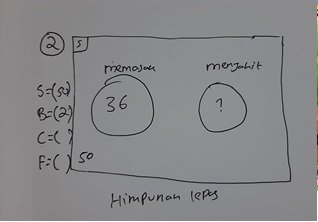Analysis Numerical Literacy Ability in Middle School Students in Material Set
DOI:
https://doi.org/10.25217/numerical.v7i1.2896Keywords:
Analysis, Materials Sets, Numerical Literacy AbilityAbstract
This study identified the numeracy literacy skills of Almuttaqin MTS students in a rigid material. A hallmark of numeracy literacy is the capacity to apply numbers and related symbols to operations on algebraic forms, analyze data, and understand analysis findings to predict and make judgments. Tests and interviews were used to collect data, which were then analyzed through data reduction, presentation, and conclusion. Based on the findings, the numeracy literacy skills of MTS Almuttaqin students, one student (4%) is included in the excellent group for numeracy literacy, nine students (34%) are included in the excellent category, 15 students (50%) are included in the good category, and five students (11)% is included in the less category. Students with high numeracy literacy (ST) can use various numbers and symbols to solve problems, analyze information to make predictions, evaluate the findings of their analysis, and make decisions when handling the challenges of the given material. Using various numbers and symbols to solve problems and analyze information is the only marker that satisfies students with moderate numeracy literacy (SD). They have not yet reached the stage where they can make the best choices regarding their assigned content. Students with limited numeracy literacy (SR) only write numbers and are identified when completing assignments. As a result, SD and SR have not fully learned numeracy skills. The indications that were not fulfilled were caused by mistakes made by students, including not carefully recording known and asked data, choosing an inappropriate problem-solving approach, and not understanding ideas well enough to answer questions problem.
References
A. G. E. Putri and D. U. Wutsqa, “Students’ Mathematical Connection Ability in Solving Real-world Problems,” J. Phys.: Conf. Ser., vol. 1320, no. 1, p. 012066, Oct. 2019, doi: 10.1088/1742-6596/1320/1/012066.
P. Yuanita, H. Zulnaidi, and E. Zakaria, “The effectiveness of Realistic Mathematics Education approach: The role of mathematical representation as mediator between mathematical belief and problem solving,” PLoS One, vol. 13, no. 9, p. e0204847, Sep. 2018, doi: 10.1371/journal.pone.0204847.
D. P. Utomo and D. L. Syarifah, “Examining Mathematical Representation to Solve Problems in Trends in Mathematics and Science Study: Voices from Indonesian Secondary School Students,” IJEMST, vol. 9, no. 3, pp. 540–556, Apr. 2021, doi: 10.46328/ijemst.1685.
F. Ozdamli and H. Ozdal, “Developing an Instructional Design for the Design of Infographics and the Evaluation of Infographic Usage in Teaching Based on Teacher and Student Opinions,” Eurasia Journal of Mathematics, Science and Technology Education, vol. 14, Jan. 2018, doi: 10.29333/ejmste/81868.
Andreas Schleicher, “Educating Learners for Their Future, Not Our Past,” Sage Journals, vol. 1, no. 1, pp. 58–75, 2018, doi: 10.30926/ecnuroe2018010104.
17204153107 RESTI FAUZIAH, “Scaffolding pada Pemecahan Masalah Soal Cerita Bentuk Aljabar di Kelas VII-A MTs Al-Ma’arif Tulungagung Tahun Ajaran 2018/2019,” Jun. 19, 2019. http://repo.iain-tulungagung.ac.id/11600/ (accessed Dec. 02, 2022).
I. Mustain, “Kemampuan Membaca Dan Interpretasi Grafik Dan Data: Studi Kasus Pada Siswa Kelas 8 SMPN,” sceducatia, vol. 4, no. 2, Jul. 2015, doi: 10.24235/sc.educatia.v4i2.493.
S. Hartatik and N. Nafiah, “Kemampuan Numerasi Mahasiswa Pendidikan Profesi Guru Sekolah Dasar Dalam Menyelesaikan Masalah Matematika,” Education and Human Development Journal, vol. 5, no. 1, pp. 32–42, Apr. 2020, doi: 10.33086/ehdj.v5i1.1456.
M. Sabirin, “Pengaruh Pembelajaran Berbasis Masalah Terhadap Kemampuan Pemecahan Masalah, Komunikasi Dan Representasi Matematis Siswa SMP,” Universitas Pendidikan Indonesia, 2011. Accessed: Dec. 02, 2022. http://repository.upi.edu
R. Lusiana, “Analisis Kesalahan Mahasiswa Dalam Memecahkan Masalah Pada Materi Himpunan Ditinjau Dari Gaya Kognitif,” JPPM (Jurnal Penelitian dan Pembelajaran Matematika), vol. 10, no. 1, Art. no. 1, Feb. 2017, doi: 10.30870/jppm.v10i1.1290.
I. L. Nur’aini, E. Harahap, F. H. Badruzzaman, and D. Darmawan, “Pembelajaran Matematika Geometri Secara Realistis Dengan GeoGebra,” Matematika: Jurnal Teori dan Terapan Matematika, vol. 16, no. 2, Art. no. 2, Dec. 2017, doi: 10.29313/jmtm.v16i2.3900.
S. Maslihah, S. Waluya, Rochmad, and A. Suyitno, “The Role Of Mathematical Literacy To Improve High Order Thinking Skills,” Journal of Physics: Conference Series, vol. 1539, p. 012085, May 2020, doi: 10.1088/1742-6596/1539/1/012085.
H. S. Iswara, F. Ahmadi, and D. D. Ary, “Numeracy Literacy Skills of Elementary School Students through Ethnomathematics-Based Problem Solving,” Interdisciplinary Social Studies, vol. 2, no. 2, pp. 1604–1616, Nov. 2022, doi: 10.55324/iss.v2i2.316.
L. R. Hidayah and A. Mustadi, “The Implementation of The Flipped Classroom for Early Grade Students in Elementary School,” International j.of Elementary Education, vol. 5, no. 1, p. 98, Apr. 2021, doi: 10.23887/ijee.v5i1.33151.
D. J. Purpura, E. C. Litkowski, and V. Knopik, “Mathematics and Reading Develop Together in Young Children: Practical and Policy Considerations,” Policy Insights from the Behavioral and Brain Sciences, vol. 6, no. 1, pp. 12–20, Mar. 2019, doi: 10.1177/2372732218815923.
B. Barnawi and F. A. Pratama, “Efforts to Improve Counting Skills Using Number Card Displayers,” ARJI, vol. 1, no. 4, pp. 217–227, 2019.
L. Bernabini, P. Bonifacci, and P. F. de Jong, “The Relationship of Reading Abilities With the Underlying Cognitive Skills of Math: A Dimensional Approach,” Frontiers in Psychology, vol. 12, 2021, Accessed: Jun. 24, 2023. [Online]. Available: https://www.frontiersin.org/articles/10.3389/fpsyg.2021.577488
A. P. Maulidina and S. Hartatik, “Profil Kemampuan Numerasi Siswa Sekolah Dasar Berkemampuan Tinggi Dalam Memecahkan Masalah Matematika,” Jurnal Bidang Pendidikan Dasar, vol. 3, no. 2, Art. no. 2, Jul. 2019, doi: 10.21067/jbpd.v3i2.3408.
I. Nurjanatin, G. Sugondo, and M. M. H. Manurung, “Analisis Kesalahan Peserta Didik Dalam Menyelesaikan Soal Cerita Pada Materi Luas Permukaan Balok Di Kelas Viii – F Semester II SMP Negeri 2 Jayapura,” Jurnal Ilmiah Matematika Dan Pembelajarannya, vol. 2, no. 1, Art. no. 1, 2017, Accessed: Dec. 02, 2022. https://ejournal.uncen.ac.id/index.php/JIMP/article/view/252
L. I. Komalasari, “Analisis Tingkat Kesulitan Siswa Dalam Kemampuan Menyelesaikan Masalah Matematika Materi Persamaan Kuadrat,” Histogram: Jurnal Pendidikan Matematika, vol. 4, no. 1, p. 139, Aug. 2020, doi: 10.31100/histogram.v4i1.566.
M. R. Mahmud and I. M. Pratiwi, “Literasi Numerasi Siswa Dalam Pemecahan Masalah Tidak Terstruktur,” Kalamatika: Jurnal Pendidikan Matematika, vol. 4, no. 1, Art. no. 1, Apr. 2019, doi: https://10.22236/Kalamatika.vol4no1.2019pp69-88.

Downloads
Published
How to Cite
Issue
Section
License
Copyright (c) 2023 Ulfa Luthfiani, Sehatta Seragih, Elfis Suanto, Maimunah

This work is licensed under a Creative Commons Attribution-ShareAlike 4.0 International License.






